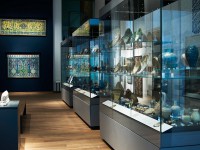Room 31 | Islamic Middle East gallery
Explore artefacts made over a period of more than 1000 years in the heart of the Islamic world.

‘We saw indeed here so many apartments [and separate chambers], all of which were adorned in tile work of blue and gold with many other colours . . . and all was so marvellously wrought that even the craftsmen of Paris [, who are so noted for their skill,] would hold that which is done here to be of very fine workmanship.'
(From the account of the visit of the Castilian ambassador Ruy Gonzales de Clavijo to the court of Timur [Tamerlane] in 1403-06)
One of the glories of Islamic art is its architecture. Construction techniques varied between regions according to local knowledge, the availability of materials and differing climates. However, certain shapes and decorative motifs are shared throughout the Islamic world.
From the very first centuries of Islam, wealthy members of society paid for the creation of private and public buildings, like houses and palaces, mosques, tombs, shrines, fountains, and baths. Great emphasis was given to the architectural decoration of both interiors and exteriors. Stucco, stone, wood, mosaic, painting and tiles were used to cover and embellish the surfaces.
Glazed bricks and tiles played a major role in the decoration of Islamic buildings - the variety of the patterns and colours used at different times and places can be seen in the examples from our collection.
 Set of forty-eight tiles displaying vases and cypress trees amid flowers (EA1977.15)
Set of forty-eight tiles displaying vases and cypress trees amid flowers (EA1977.15)
 Semi-circular tile depicting Yusuf appearing before the women on Memphis (EA1965.169)
Semi-circular tile depicting Yusuf appearing before the women on Memphis (EA1965.169)
 Set of forty-eight tiles displaying birds and animals in a landscape (EA1979.16)
Set of forty-eight tiles displaying birds and animals in a landscape (EA1979.16)
 Set of five tiles depicting Yusuf appearing before the women of Memphis (EAX.3135)
Set of five tiles depicting Yusuf appearing before the women of Memphis (EAX.3135)
Notice
Objects may have since been removed or replaced from a gallery. Click into an individual object record to confirm whether or not an object is currently on display. Our object location data is usually updated on a monthly basis, so contact the Jameel Study Centre if you are planning to visit the museum to see a particular Eastern Art object.
© 2013 University of Oxford - Ashmolean Museum





